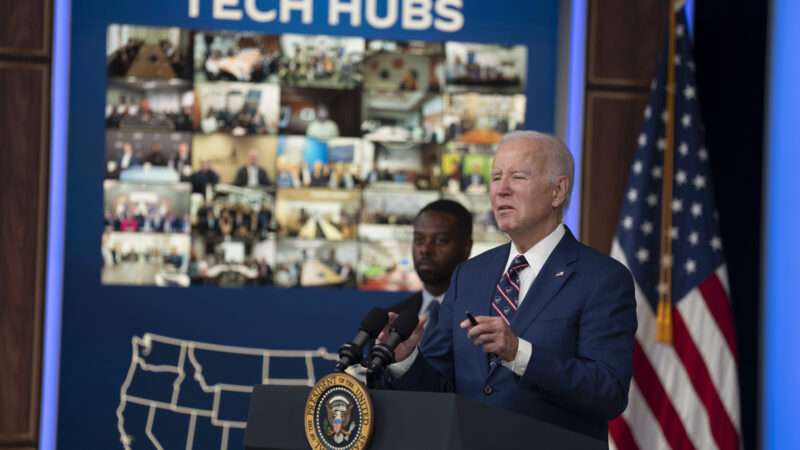
“If at first you don’t succeed, try, try again” appears to be the idea underlying President Joe Biden’s new economic initiative. On Monday, the White House announced the selection of 31 regional “technology hubs” that will spur innovation, manufacturing capacity, and employment with the help of generous federal subsidies.
“We’re going to invest in critical technologies like biotechnology, critical materials, quantum computing, advanced manufacturing—so the U.S. will lead the world again in innovation across the board,” Biden said in a press conference announcing the new initiative, per the Associated Press.
These new hubs, spread across the country, will receive an initial $500 million in federal subsidies—a slice of the $10 billion included in the 2022 CHIPS and Science Act to stimulate investment in high-tech industries.
The hope is to create innovation centers outside the country’s existing “superstar” cities like Seattle, Austin, and New York City—where high-tech employment is currently concentrated.
For all the president’s optimism and federal funding, the history of “place-based” investment policies and economic theory suggest that this latest effort to create dispersed tech hubs will be unsuccessful.
Indeed, the idea of federally subsidized, special investment zones is hardly a new one.
As part of the 2017 Tax Cuts and Jobs Act, Congress created the Opportunity Zones program, which gives investors tax credits for investing in state-designated census tracts with high concentrations of poverty. The idea was to direct investment to areas in desperate need of it.
Yet the research on the program’s results has been mixed to negative. A December 2022 white paper published by the Brookings Institution reviewing four recent studies on Opportunity Zones found that investments under the program generally flowed to zones with higher incomes and education levels that were already experiencing growth. Real estate prices increased in Opportunity Zones, but commercial activity and business formation didn’t.
“There’s no evidence that [Opportunity Zone] tax incentives have significantly increased commercial investment in [Opportunity Zones], nor have such outcomes as new business formation, new business loans, commercial diversity, or consumer spending substantially changed,” is the summary of one paper included in the Brookings literature review.
Reason‘s Ronald Bailey reported on a working paper from earlier this year finding that Opportunity Zones actually reduced business formation by shifting investment to incumbent firms, therefore reducing the competitiveness of new firms.
Before Opportunity Zones were President Barack Obama’s efforts to create a network of high-tech “manufacturing innovation hubs” across the country with the help of $70 million in federal subsidies per hub.
The results of this effort were likewise unimpressive when judged by the number of new jobs they created in their targeted sectors. In 2015, for instance, Obama made a big show of announcing $70 million in federal subsidies for a materials research center in Knoxville, Tennessee.
According to data in a 2019 Brookings paper making the case for place-based investments, the Knoxville metro area added about 1,200 jobs in innovation industries from 2005 to 2017. Nevertheless, its national share of jobs in this sector stayed flat.
Another subsidized manufacturing hub much ballyhooed by the Obama administration was a 3D printing America Makes lab in Youngstown, Ohio, which was supposed to lead a revival of American manufacturing. Federal efforts to support the Youngstown lab started in 2012. By 2014, Reuters was reporting that manufacturing employment in the area had fallen slightly to 29,600 factory jobs. As of August 2023, the Youngstown metro area has only 26,600 manufacturing jobs.
There’s a reason federal subsidies have a difficult time creating innovation centers from scratch. As it turns out, it’s easiest to produce innovation in places where there’s already a lot of economic activity happening. Firms can draw off a wider pool of highly skilled workers. These workers can flit between more employers, carrying skills and new ideas with them. The close proximity of capital and labor allows more collaboration (planned or spontaneous). A larger market allows for greater specialization and division of labor.
This positive-sum agglomeration explains why so much high-tech industry and innovation is currently concentrated in a few large urban areas. The Biden administration is explicitly going to war with the logic of agglomeration by trying to seed new tech centers in places where they don’t exist currently.
Odds are that the White House’s tech hubs will be a similar flop to previous efforts at creating “opportunity zones” and “manufacturing hubs” out of nothing. At best, it will likely shift a few more jobs and federal dollars to existing, federally funded research centers.
At worst, it will funnel subsidies to swing districts and politically connected cronies who will be able to show little new innovation for all the federal largesse they receive.
It would probably be too much to call Biden’s latest gambit crazy, given how previous presidential administrations from both parties have tried similar ideas. Nevertheless, there is a word for trying the same thing that failed over and over again and expecting different results—and it’s not smart.
The post Joe Biden's Plan for 31 Subsidized 'Tech Hubs' Is an Old, Tired Idea That's Doomed To Fail appeared first on Reason.com.
from Latest https://ift.tt/b8j31fY
via IFTTT